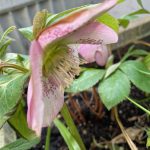I recently read a quote from Charles Lamb – ‘No-one ever regarded the first of January with indifference’. This resonated with me. This year the day was spent with family gathered, alongside more celebratory reasons, to pack up the family home of my very elderly step-mother. So a poignant day indeed, steeped in memories, with geo-politics and the appalling unfolding human tragedies, as well as the prospect of severe flooding more locally, touching all our lives too, albeit peripherally. Moments of reflection and anticipation mingled with more immediate feelings and associations, as well as the practical questions generated by the accumulation of books, pictures and other treasures with limits of space and mixed emotions hampering the task of selection.
*Meanwhile the balcony has begun the year eagerly. The silver and green evergreens are shining with health, bulbs are appearing and a few tulbaghia flowers are clinging on.
Emerging from Winter
The arrival of the watering can in the en-suite bathroom is an indicator of what is to come. It seems too early in the year, and the risk of cold and icy conditions returning too great, to turn on the outdoor water tap generously shared by my neighbour and providing the majority of the water supply later in the season for our top floor, 5th* floor, sun-soaked balconies. But the wind and now sun are rapidly drying out the smaller containers on my south facing balcony, leading off the main bedroom, so trips across the fitted carpet, negotiating slippers and other hazards wil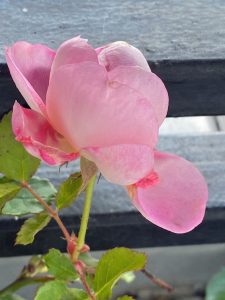 l become a familiar pattern until any risk of frosts is past.
l become a familiar pattern until any risk of frosts is past.
Rather than heading for the gym to lift weights, I’ve also been hauling various bags of compost up from the passage outside our bedroom window (which has provided over winter storage) through the bedroom and out through the doors onto the largest planted area. This manages to accommodate quite a wide range of plants which have overwintered remarkably happily, including a single rose which flowered on Christmas Day, together with enough space for two or three to be gathered together with a glass of wine or a cup of coffee, in a space 10 metres x 2 metres to be exact.
* This is a recalculation – since the ground floor properties are duplex apartments, with three floors of the original school building above and above that our much more recent addition (which replaced the ornate and gabled original 5th floor lost to a WW11 incendiary bomb) it might be more accurate to think of the balcony or terrace, as you will, to be on the 5th floor not 4th as previously indicated. Whatever, we are quite high up so quite something to be visited by bees and birds on their peregrinations, and completely out of reach, unless helped by a thermal, for most butterflies.
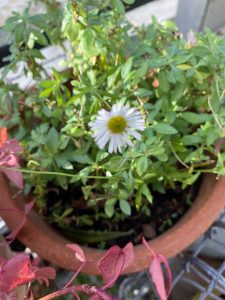 After it seems weeks of heavy winds and more rain, earlier today the sun is bright and the winds have calmed down, so I have taken advantage of a peaceful moment to pamper some of the long suffering plants which the persistent winds have dried out, or which are habitually vulnerable to water shortage (that may or may not suit them) living as they do in the rain-shadow, under the roof’s projection. So, I have begun the gardening year as I hope to go on, enjoying the sights and sounds around while encouraging the most reliable plants into life and reminding myself of the plants that need to be pruned before too long, including roses, late flowering salvias and gaura and my recently acquired pomegranate. With gardening, as with cooking, sticking to the advice/recipe doesn’t come naturally but I’m keen to give my pomegranate the best possible chance of producing fruit, due in another year or so after a couple more seasons aloft. Rosemary is in flower, as are one or two hellebores, but other plants are struggling including the wallflowers that I planted reluctantly. My indifference apparently being contagious and the newer, dwarf, container friendly plants are decidedly un-floriferous.
After it seems weeks of heavy winds and more rain, earlier today the sun is bright and the winds have calmed down, so I have taken advantage of a peaceful moment to pamper some of the long suffering plants which the persistent winds have dried out, or which are habitually vulnerable to water shortage (that may or may not suit them) living as they do in the rain-shadow, under the roof’s projection. So, I have begun the gardening year as I hope to go on, enjoying the sights and sounds around while encouraging the most reliable plants into life and reminding myself of the plants that need to be pruned before too long, including roses, late flowering salvias and gaura and my recently acquired pomegranate. With gardening, as with cooking, sticking to the advice/recipe doesn’t come naturally but I’m keen to give my pomegranate the best possible chance of producing fruit, due in another year or so after a couple more seasons aloft. Rosemary is in flower, as are one or two hellebores, but other plants are struggling including the wallflowers that I planted reluctantly. My indifference apparently being contagious and the newer, dwarf, container friendly plants are decidedly un-floriferous.
Unexpected Visitor
For most of my life I have lived in areas in Southern England where grey squirrels are an everyday presence or pest depending on your point of view. Bold and athletic they may be, and skillful at accessing our dustbins certainly, but not wild creatures that encourage me to stop and stare – until last week when our neighbour spotted a white squirrel leaping from tree to tree. Later I noticed it running along the top of the fence separating us from the property next door.
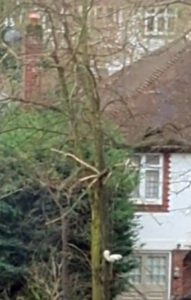 The branches of the tall lime trees above intertwine so the wild life can circulate freely but closer to the ground the squirrel was briefly much more conspicuous in its white coat and evidently well-fed body.
The branches of the tall lime trees above intertwine so the wild life can circulate freely but closer to the ground the squirrel was briefly much more conspicuous in its white coat and evidently well-fed body.
Apparently mammalogists estimate that the odds of a female grey squirrel giving birth to an albino offspring are 1 in 100,000, so even more surprising that it has chosen to frequent the trees and gardens in our particular corner of South West London, with only a fence panel separating it from the A3 and the slow moving traffic travelling into the Metropolis.
And So It Begins
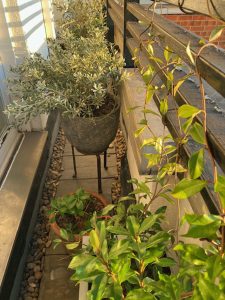 I don’t think I planned to have a planted space which gives a nod to sunnier, Southern climes although I’m very happy that is how things hereabouts have evolved. Particularly since the protective row of very elderly, and disease ridden horse chestnuts were chopped down, leaving the balcony fully exposed to wind and weather, as well as the heat of the sun, it is the mediterranean species which have risen to the challenge – olives, rosemary, bay, and now pomegranate, as well as lavender, thanks to the growing tips I was given in the comments section, thyme and lemon verbena, together with Convolvulus cneorum ‘silver bush’ and eucalyptus which while native to Australia also favours a mediterranean climate, as do the tulbaghia, native to South Africa, another region with a mediterranean climate. The Summer jasmine (a climber with white fragrant flowers in Summer, not to be confused with Winter jasmine with yellow flowers on bare stems) has also managed to hold on to its leaves over Winter and is happily stretching out along the railings filling in some gaps.
I don’t think I planned to have a planted space which gives a nod to sunnier, Southern climes although I’m very happy that is how things hereabouts have evolved. Particularly since the protective row of very elderly, and disease ridden horse chestnuts were chopped down, leaving the balcony fully exposed to wind and weather, as well as the heat of the sun, it is the mediterranean species which have risen to the challenge – olives, rosemary, bay, and now pomegranate, as well as lavender, thanks to the growing tips I was given in the comments section, thyme and lemon verbena, together with Convolvulus cneorum ‘silver bush’ and eucalyptus which while native to Australia also favours a mediterranean climate, as do the tulbaghia, native to South Africa, another region with a mediterranean climate. The Summer jasmine (a climber with white fragrant flowers in Summer, not to be confused with Winter jasmine with yellow flowers on bare stems) has also managed to hold on to its leaves over Winter and is happily stretching out along the railings filling in some gaps.
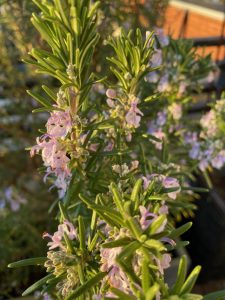 As I look out from my bedroom window, all these predominantly evergreen/silvergreen plants, some now grown into sizable small trees, are in good health and have together formed a well established and more or less complete green wall offering some protection to the rather more delicate plants yet to take the plunge and put in an appearance. I assume that the root systems of the aforementioned happy, healthy but generally heat seeking plants have found that the heat rising from the flat underneath (it is in reality a small and irregularly shaped roof terrace sitting on top of the property below, rather than a true balcony projecting from the building) to their liking and as long as the there are no problems with the integrity of the tiled surface of the roof terrace and no gaps in the membrane protecting the flat below, it is hopefully a win-win situation, with the plants reducing heat loss in Winter and providing a shaded, cooler surface in Summer.
As I look out from my bedroom window, all these predominantly evergreen/silvergreen plants, some now grown into sizable small trees, are in good health and have together formed a well established and more or less complete green wall offering some protection to the rather more delicate plants yet to take the plunge and put in an appearance. I assume that the root systems of the aforementioned happy, healthy but generally heat seeking plants have found that the heat rising from the flat underneath (it is in reality a small and irregularly shaped roof terrace sitting on top of the property below, rather than a true balcony projecting from the building) to their liking and as long as the there are no problems with the integrity of the tiled surface of the roof terrace and no gaps in the membrane protecting the flat below, it is hopefully a win-win situation, with the plants reducing heat loss in Winter and providing a shaded, cooler surface in Summer.
Readers of previous posts will know that all is not always well in Paradise. Membranes perish and mortar ages.
Meanwhile if asked what my tip of the week would be – I would suggest that if you are planning to grow substantial plants with vigorous root systems, do ensure they are sitting on a suitable surface, well away from any nook or crevice that might tempt an adventurous root. Buddleia (the butterfly bush) are wonderful for butterflies as the name suggests, extremely happy growing alongside railway tracks and have striking flowers, although I quickly tire of their dead and dying flower heads. ‘Container’ varieties can now be bought, but in my view should only be planted well away from any tempting roof felt or other building material, as the consequential damage may lead to leaks. Our leaks (two in the last ten years) have been very distressing for all involved, but my plants, I was reliably informed, were not the cause of the problem although moving containers out of the way to gain access added to the difficulties and made the situation additionally fraught.
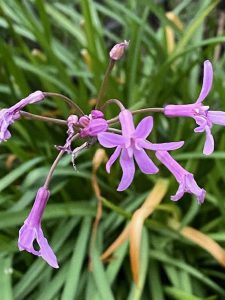 I have taken note and hopefully access is a little easier now in case of emergency.
I have taken note and hopefully access is a little easier now in case of emergency.
And on a brighter note – if you like the possibility of year round fresh green leaves and flowers frrom April to December I recommend tulbaghia which come in all sorts of sizes and colour tones.
In some ways they are similar to, but less particualr than agapanthus which would struggle to cope with the cold damp winters and ferocious winds up aloft.
What to Keep, What to replace, What to Change?
I delight in the flowers of the cistus, or rock rose family, including Cistus purpureus, with dark pink flowers and a deep maroon centre. For a few precious days in early Summer the flowers contribute briefly to the visual delights offered by my mini-garden, coming and going as they do for a short while, before giving way to ever more ungainly growth. The leaves generally cling on through the Winter until the warmer days arrive again but the plant, which is not happy to be pruned hard, can quickly take over, leaving very little space for later flowering plants. For the moment I’m in a generous mood and as long as this year’s flowers are worth the wait it stays.
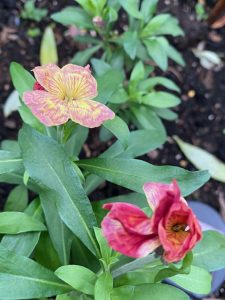 But the wallflowers are going – I do want the space for the rose I’ve already bought. And so are the two buddleia plants (see above) that I have tried to remove from the containers that they shared last year with gaura (which I will keep) and the Convolvulus cneorum (which I will also keep) but any signs of regrowth and I will quickly have another go at removing all signs of life. Buddleia are very persistent, but so am I in certain situations and this might be one.
But the wallflowers are going – I do want the space for the rose I’ve already bought. And so are the two buddleia plants (see above) that I have tried to remove from the containers that they shared last year with gaura (which I will keep) and the Convolvulus cneorum (which I will also keep) but any signs of regrowth and I will quickly have another go at removing all signs of life. Buddleia are very persistent, but so am I in certain situations and this might be one.
I’ve also decided to give the thalictrum one more year. It has self seeded all around but the plants I bought originally are probably nearing the end of their lives.
I’m also rather unsure about the added value offered by my latest ornamental purchase – a contemporary weather vane designed to stand in a container. I think it would look better from afar but this is disappointingly impractical given the small scale of my planted plot. I failed to do any measuring before hand and as it measures 50cms across, and needs space to rotate, a suitable container is somewhat elusive. I also hadn’t thought about the risk of a storm force wind lifting it out of its apparently secure footing so it needs to be as far away as possible from any panes of glass. This would really mean being out of sight which rather defeats the object of the exercise although a soft landing would be better than being flung against closed, glazed doors.
While I dither about it’s future, the weather vane, with garden birds replacing the traditional cockerel, is in a temporary location, away from any glass, but in the way. And I’m not sure I like it anyway so I may have fallen foul of my tendency to browse on-line when the opportunity to be out and about, either on the balcony, or the allotment, is impractical. Another year I might stick to the safer option of stocking up on compost, and combine keeping up my exercise programme, which includes walking up 95 steps as often as I can face it, with moving the compost up from the car, and so be better prepared for the various demands of gardening as signs of Spring lure me outside.




